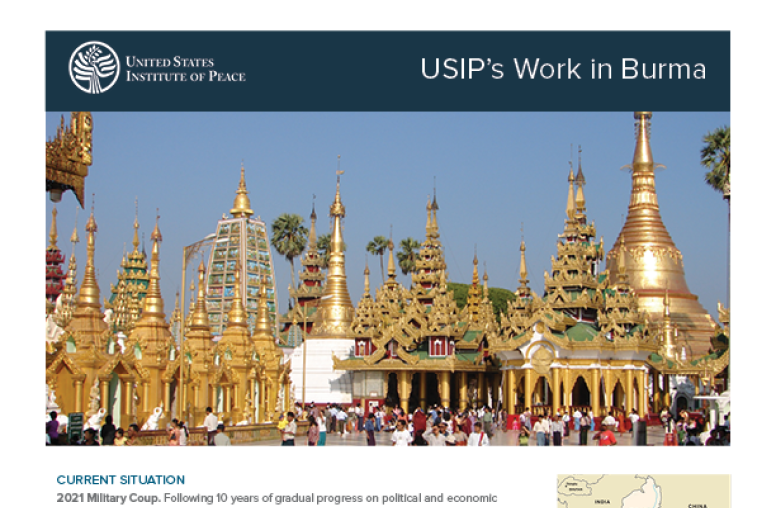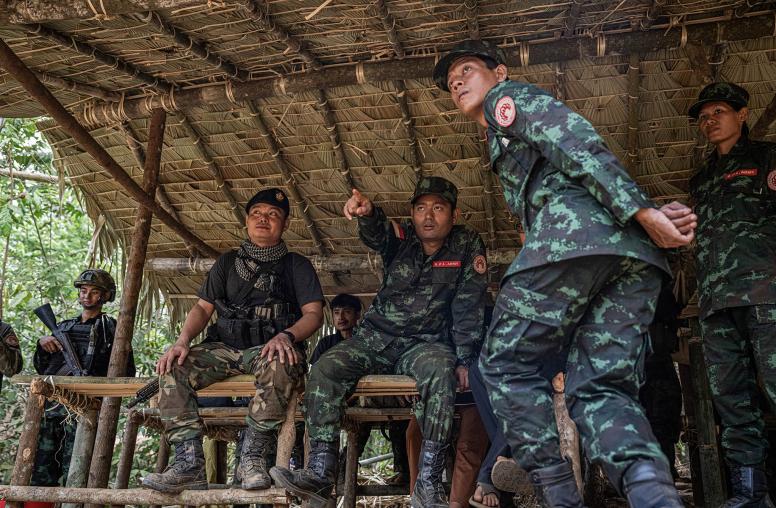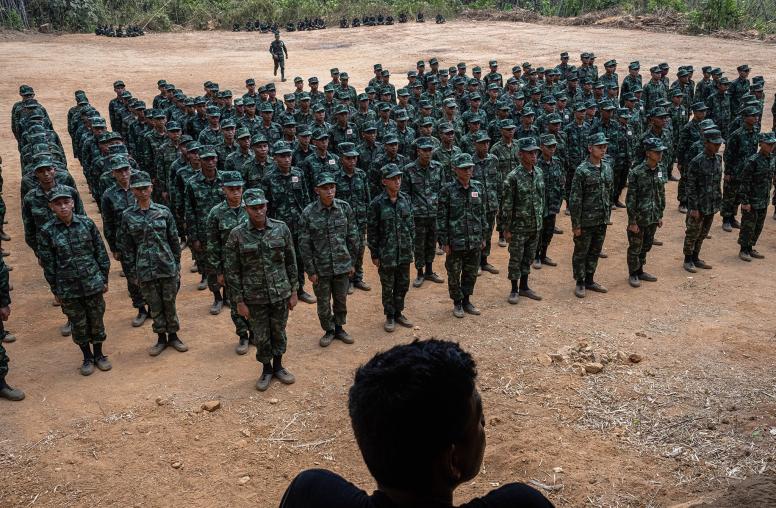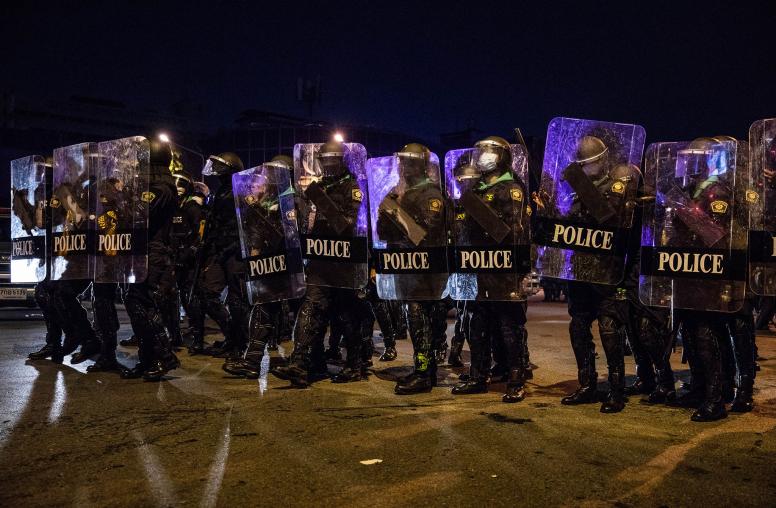In Myanmar’s Rakhine State, a Fraying Truce May Hold Key to Anti-Regime Fight
A potent ethnic armed group, tied to the resistance, appears to be inching away from a cease-fire and back to the battlefield.
Myanmar has been crippled by growing political turmoil and militant resistance since the army overthrew the elected civilian government on February 1, 2021. Today, most of the country is engulfed in a virtual civil war. In Rakhine State, however, home to one of Myanmar's most powerful ethnic armed organizations, a tenuous peace still prevails under a cease-fire reached with the pre-coup military in 2020. At the time, the truce benefited both the military and its adversary, the Arakan Army. Now, under the pressures unleashed by the military’s power grab, that deal is fraying. Should it collapse, the coup regime will face a vastly strengthened insurgency. The people of Rakhine, collaterally, will all but certainly suffer brutal counterstrikes from the air force and artillery of a military untroubled by its record of war crimes.

The ruling junta, whose coup sparked an immediate popular uprising, has lost considerable territorial control since it seized power. The generals face a threat on multiple fronts throughout the country from People's Defense Forces (PDFs), citizen groups that have armed and organized to fight the regime, and from battle-tested ethnic armed organizations (EAOs) that have either joined with the PDFs or taken advantage of the chaos to advance their drives for long-sought autonomy.
So far, the Arakan Army (AA) and its claimed 30,000 troops in Rakhine have stayed out of the fight. But today, all eyes are on the force, which appears to be inching back toward the battlefield after having consolidated administrative control in much of Rakhine State, an area bordering Bangladesh. The AA’s re-engagement would not only challenge the military’s position on Myanmar’s western frontier but could radically change the balance of military power by stretching the dwindling resources of the Sit-Tat, as the military is known, to yet another front.
Many analysts rightly argue that the junta is unlikely to be crippled until either pro-resistance EAOs — now called Ethnic Revolutionary Organizations (EROs) — and PDFs better coordinate their military activities or another large ERO yet to engage enters the fray. Crippled or not, the generals have lost administrative power in large parts of the country over the past year, denying them control outside of urban areas.
The Spring Revolution and the Arakan Army
The Arakan Army was formed in April 2009 by 26 Arakan youth in Laiza, a mountain town on Kachin State’s border with China, under the guidance of the powerful Kachin Independence Army. After moving into Rakhine State in 2015 to gain greater autonomy, the AA expanded rapidly to become one of the military’s most dangerous foes. Just three months before the coup, the Sit-Tat and AA agreed on an informal cease-fire. In addition to its ranks in Rakhine, the AA says it also has at least 5,000 members supporting allies elsewhere. Its political wing, the United League of Arakan (ULA), claims to administer over two-thirds of Rakhine State.
As the nationwide uprising against the coup regime intensified in early 2021, the AA issued a statement on April 10, the anniversary of its founding, urging the Rakhine public not to participate in the Civil Disobedience Movement and street protests in Rakhine State and to focus instead on the strategic goal of achieving political autonomy.
Judging that AA involvement in the resistance movement could spell disaster, the junta’s administrative council extended an olive branch. The 18-month internet shutdown in Rakhine was lifted and the Arakan National Party leader was offered a seat on the council. Rakhine nationalist politician Dr. Aye Maung and Rakhine writer Wai Han Aung were released from detention on February 13, 2021, followed by the AA chief’s family members on June 9.
The AA’s posture toward the junta has been ambiguous, providing considerable support to resistance forces outside of Rakhine State, even as anti-junta activity has remained low in Rakhine itself.
Specifically, the AA has provided training or arms for a minimum of 11 resistance groups; at least five have disclosed AA support.
- The Bamar People’s Liberation Army (BPLA), led by a prominent human rights activist and poet, stated that the Arakan Army and its Brotherhood Alliance have supported them since their formation, and the AA and its allies have reiterated their backing.
- The Student Armed Force formed by the University Student Union (Yangon), the People’s Revolution Alliance (Magway) and Mara Defense Force disclosed that they had received weapons, training, military support and tactical guidance from the AA.
- On April 26, 2022, the Mindat Township branch of the Chinland Defense Forces released footage of recruits returning from AA training.
In addition to AA support for PDFs, just a month after the coup, Rakhine sources in Kachin State indicated that AA troops were fighting the Sit-Tat together with the KIA and their Brotherhood allies in northern Myanmar.
On March 30, 2021, the Brotherhood Alliance, which includes the AA, Myanmar National Democratic Alliance Army, and the Ta’ang National Liberation Army warned that if Sit-Tat didn’t immediately stop brutalizing peaceful protesters and address the political solutions demanded by the public, the Alliance would “support and cooperate with our oppressed brethren and multi-ethnic people who are waging the Myanmar Spring Revolution in self-defense against the Myanmar Army.” Ten days later — a day after troops killed at least 82 people with grenades launched at protesters in Bago city — the Alliance attacked a police station in Shan State’s Lashio Township, leaving several officers dead.
The AA also maintains good relations with many of the country’s most active EROs, including the Karen National Union and the Karenni National Progress Party.
Politically, although it is not an active member, the AA has solid ties with the National Unity Government (NUG), comprised of officials ousted in the coup. Sources within the NUG and AA say they share the common objective of unseating the military regime.
A Feeble Cease-fire
Recognition that discreet AA support for the resistance has not significantly weakened the junta has sparked debate about whether direct AA confrontation with the military in Rakhine State might potentially tip the scales in favor of the anti-junta forces.
The International Crisis Group, reflecting on the consequences of renewed fighting for the Rakhine people, recommended that the AA and the junta formalize their cease-fire. Others argue such a deal is unrealistic.
First, neither party is comfortable with the status quo. The junta is increasingly intolerant of the ULA’s expanding administrative control in Rakhine and has openly threatened or detained many ULA administrators. Most recently, junta forces launched an air strike on an AA base in Karen National Union territory in Karen State, killing at least six soldiers, injuring many others and destroying a garment factory.
Secondly, the ULA will not enter any agreement that fails to recognize its political autonomy — a demand the junta cannot and will not meet. An inclusive and sustainable deal would also need to include basic points regarding the rights of Rohingya in Rakhine State. This is unrealistic so long as the junta actively attempts to incite discord between Rohingya and Rakhine communities.
Finally, if an informal cease-fire has not brought peace, a formal one would not either. Although Rakhine State has remained comparatively stable since the coup, its people have suffered serious social and economic damage from junta restrictions and from the nationwide economic collapse caused by the coup.
Renewed War in Rakhine State?
Since the AA publicly rejected the junta’s invitation to a “peace talk” in early June, tensions between the AA and the military have escalated. On June 13, while visiting Rakhine’s capital Sittwe, the vice chief of junta administration told his troops to be “ready to fight anytime”.
A week later, the military began arresting people linked to the AA in Sittwe, Mrauk-U, Kyauktaw and Panagyun. They blocked the gates of these towns and now conduct regular checks of hotels, guest houses and residences, searching for AA fighters and ULA governance officials. The AA has responded by arresting a naval lieutenant and several soldiers in Sittwe, Panagyun and Kyauktaw. Recently, the AA claimed to have welcomed hundreds of Sit-Tat defectors in Rakhine since the coup.
Rumors of resurgent war in Rakhine State have circulated since last November when small-scale clashes broke out in Maungdaw and Paletwa township. But tensions eased each time war appeared imminent, suggesting neither side sees a benefit in returning to open conflict right now.
Even so, the rising tension between the AA and junta in recent months could lead to new fighting for three main reasons.
- The junta is blocking further expansion of ULA/AA territorial control in Rakhine State.
- Coup leader Min Aung Hlaing is thought to face growing pressure from within the Sit-Tat. Military analysts believe that senior commanders involved in past campaigns against the AA resent the commander’s decision to continue the cease-fire while a group they identify as an enemy supports the resistance elsewhere.
- The monsoon season reduces the military’s air power advantage, so the time may be ripe for the AA to re-enter the fight.
If armed clashes do break out, they are most likely to occur first in areas where the AA and junta are unwilling to cede strategic territory. For example, if the AA attempts to capture positions near Maungdaw town, particularly the formal border gates to Bangladesh where the military collects considerable tax revenue, the junta will undoubtedly respond forcefully.
Implications of a New Front in the Civil War
Renewed war in Rakhine State would have nationwide consequences. Fighting could spread quickly from rural areas controlled by the AA into urban zones of Rakhine State, which have never seen open warfare, as the AA seeks to push junta forces out of the state altogether. The fighting would likely migrate to allied areas, not only those controlled by the Brotherhood Alliance in northern Myanmar, but also in Irrawaddy, Bago, Magwe and Chin State, where the AA has supported PDFs.
Thus, resumption of war in Rakhine State could shift the conflict’s balance of military power in favor of the resistance. The Sit-Tat could be stretched dangerously thin by diverting its resources to this new front, presenting resistance forces in Sagaing, Magwe, Karenni, Karen and elsewhere with an opening to expand their areas of control. Balancing this possibility with the prospect of a vengeful and brutal military assault on the population of Rakhine State is the dilemma now facing AA leadership.
Kyaw Hsan Hlaing is an independent researcher and journalist from Burma’s Rakhine State, writing on human rights, political transitions, and issues related to civil war and the military coup in Burma.



